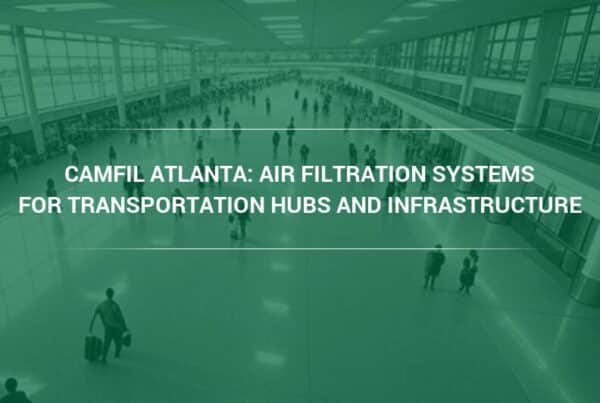How to Improve Indoor Air Quality (IAQ) in Schools — Camfil Works with a Mid-Atlantic School District to Better Protect Students’ Health
A new case study by Camfil reveals the potential for clean air in schools, even when the buildings’ existing HVAC systems are not equipped to handle high efficiency air filters.
Why is Indoor Air Quality Important in Schools?
Many people underestimate the importance of indoor air quality (IAQ), particularly for the developing lungs of young children. Indoor air can be up to fifty times more polluted than outdoor air, with a range of indoor and outdoor pollution sources affecting indoor air quality.
The two major categories of pollutants that affect air quality are gaseous pollutants and particulate matter. The EPA has identified particulate matter as one of the leading threats to human health.
Recently, local and national governments have directed more attention towards the importance of indoor air quality. Due to its propensity to spread via airborne respiratory droplets and aerosols from infected individuals, the virus that causes the COVID-19 illness can be filtered out of the air effectively enough to reduce virus transmission risks. The good news is this can be accomplished using the same technology that removes other particulate matter (PM) from the air.
Breathing clean air provides children and adults with several health and cognitive benefits:
- Cleaner, healthier lungs
- Better immune system
- Longer lifespan
- Reduced allergy and asthma symptoms
- Improved mood
- Improved productivity
Related article: Air Filtration Experts Discuss The Importance of Proper Ventilation and Filtration for Protecting Faculty and Students
Case Study — Camfil Introduces City M Air Purifiers to Mid-Atlantic Schools
Camfil worked with a Mid-Atlantic school district to improve air quality in the district’s buildings. The district, which contains three high schools and multiple middle and elementary schools, aimed to provide their students with a safer environment conducive to successful learning.
Similar to many schools and public buildings around the country, the district’s school buildings had limited space for filters in their existing HVAC systems. Replacing an entire HVAC system is not always an option because of cost and also the structural stability of the facility to handle the added equipment.
Camfil introduced the mid-Atlantic school district to the City M air purifier, an in-room air purification unit that uses HEPA filtration and is capable of moving 256 cubic feet of purified air per minute. Camfil recommended the City M as a supplement to existing filtration within the HVAC system.
To test the improvement in air quality from using the City M, Camfil representatives established baseline measurements on airborne particle concentrations using sensitive particle counters before students entered the classrooms. Measurements were taken again using those same counters after students were in the room with normal classroom activities underway and with the City M in operation. This procedure was duplicated in two district elementary schools.
After almost 2000 measurements, it was determined that particle counts in all three size ranges were reduced significantly by the City M. Additionally, the City M units were able to deliver an average of two additional air changes per hour in the classrooms which is an improvement in ventilation rates.
“As I was recording the particle counts coming out of the City M while the children were in their classrooms, I could see the numbers continuously dropping. The particle reduction rate on several size ranges was over 95%,” said Keith Woolard, Regional Product Manager for Camfil. “This is not an easy time for students or faculty and making the decision to return to in-class learning is stressful, but I believe the City M’s ability to pull very small particles out of the air gives teachers one less thing to worry about.”.
Why Camfil’s City M Air Purifier is Ideal for Schools
The City M air purifier is an ideal solution to improve indoor air quality in schools for several reasons:
- The City M uses HEPA air filtration, with each filter individually tested and certified to remove 99.995% of the most penetrating particle size (MPPS). As well as protecting students from the risk of spreading COVID-19 infections, the City M helps protect students from even the smallest particulate matter.
- The City M functions independently of the HVAC system, meaning that it is accessible to all schools, regardless of existing air handling units.
- The City M is quiet, so it will not disrupt instruction or learning.
About Camfil Clean Air Solutions
For more than half a century, Camfil has been helping people breathe cleaner air. As a leading manufacturer of premium clean air solutions, we provide commercial and industrial systems for air filtration and air pollution control that improve worker and equipment productivity, minimize energy use, and benefit human health and the environment. We firmly believe that the best solutions for our customers are the best solutions for our planet, too. That’s why every step of the way – from design to delivery and across the product life cycle – we consider the impact of what we do on people and on the world around us. Through a fresh approach to problem-solving, innovative design, precise process control, and a strong customer focus we aim to conserve more, use less and find better ways – so we can all breathe easier.
The Camfil Group is headquartered in Stockholm, Sweden, and has 33 manufacturing sites, six R&D centers, local sales offices in 30 countries, and about 4,800 employees and growing. We proudly serve and support customers in a wide variety of industries and in communities across the world. To discover how Camfil USA can help you to protect people, processes and the environment, visit us at www.camfil.us/
##
Media Contact:
Lynne Laake
Camfil USA Air Filters
T: 888.599.6620
E: Lynne.Laake@camfil.com
F: Friend Camfil USA on Facebook
T: Follow Camfil USA on Twitter
Y: Watch Camfil Videos on YouTube
L: Follow our LinkedIn Page



